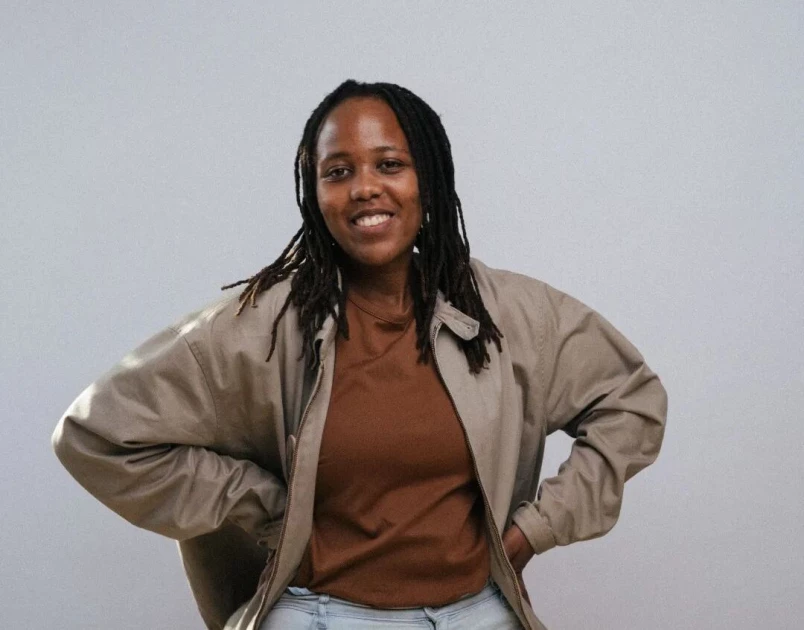Wambui Mumbi: I want my art to start conversations and give hope

Nairobi-based digital artist Wambui Mumbi. | COURTESY
At the onset of the coronavirus pandemic in March 2020, Wambui Mumbi was holed up
in her house in Nairobi, with more time at her disposal because people could
not hang out.
Then
a 22-year-old fresh university graduate, the digital artist was doing freelance graphic design and academic writing gigs from her house;
stuff she had been doing since campus days to make extra cash.
When she was a Design major at the
Technical University of Kenya, she had, because of having been brought up in
small-town Central Kenya, come to like frequenting a nearby art studio run by
legendary painter Patrick Mukabi to avoid being swallowed by the big city.
“I came from the village and did not want to be jumpy-jumpy and
get caught in the city life, and the studio offered me a place where I could go
and hang out with those people,” she says.
“Art became a safe space for me where I could have fun, and be
cool, and it did not expose me to dangers.”
Whatever would come out of it
Although she didn’t feel like she fitted in with the established
artists, she says she was happy being there and watching them do their
thing. Hers, she tells me, was “pride by association” and it went on
through her time on campus.
After graduating, her artist friends had already started doing art
professionally and were unknowingly pressuring her.
“It
was not something I did thinking I want to become an artist, but trying to see
what will come out of it,” she says, noting that she
did not want to be formally employed; a decision influenced by watching her
uncle who is an accountant.
“I decided to do something because I don’t like writing. Let me
focus on design and art, what I really want, even if I am not getting paid for
it. I am not sure if it is going to work.”
And she focused on it. Art has now become her escape from the outside world, and when she emerges to share it with the very world, it elicits conversation from social media users where she posts her work, to art fanatics who experience it in person at exhibitions.
Take
her ‘Grief’ series, for instance. She embarked on the project in June 2022 to
highlight the emotional landscape she was in after losing her grandfather, who
had been her guardian since she was 9.
“I
was afraid of talking about it (grief) because I was afraid people would not
listen to you express yourself. You are only allowed to grieve during the
burial; after that, you can almost feel the society telling you that you are
not the first to lose a parent so you should get over it,” she says.
One of the drawings titled ‘Anger’ depicts a human character, high-contrast against a bright beige background, boiling in rage with a bright-red flame-like representation of its hair.

In another, titled ‘A Million Masks’, four similarly dark human characters against the same bright background, are enjoined at the torso, but each has a different theatrical mask.

And of another depicting a lone character in an upside-down theatrical mask with a long shadow behind it, she says, “When you are as conserved as I am, you don’t really want to show the pain, so I was really desperate to hide it. I couldn’t even open up to my best friend because I didn’t think she cared enough. I wanted to hide in a room and cry myself to sleep.”
Give hope
So
why did she choose to share the deeply personal works with the world? It was to
break, she says, the tension around people expressing their sad emotions in
most African societies.
“I
talk about my grief so that next time anybody has someone around them who is
grieving, they can understand where someone is coming from and also begin the
conversation on it being okay to grieve,” Mumbi says.
She
ends up striking conversations with complete strangers with whom her work
resonates. Some have called it brave that she chose to put herself in her
vulnerable state out there.
“One
of the people who saw the work wrote to me and said, ‘I’m happy that you are
talking about this because I am not able to come out and talk about this’,” she
says, “People tell me ‘Now I understand where people in grief are coming from’.”
If you told her in March
2020 that she
would be among the artists whose work would be featured in a group exhibition
in Italy last year, Mumbi would not have believed you.
She would not have
believed you, either, if you told her that in March this year, her work would
be sitting on the walls of Mzima House along Nairobi’s Riverside Drive,
attracting curious visitors asking about the stories behind her drawings.
All this was in the
future.
And now, asked what she seeks to achieve with her work, Mumbi says, “I want my art to open up conversations about the subjects I am talking about in the pieces, and through that hopefully create safe spaces for people and give hope.”
(This publication was produced with the financial support
of the European Union. Its contents are the sole responsibility of Dennis Musau
and do not necessarily reflect the views of the European Union.)
Want to send us a story? SMS to 25170 or WhatsApp 0743570000 or Submit on Citizen Digital or email wananchi@royalmedia.co.ke
Comments
No comments yet.



Leave a Comment